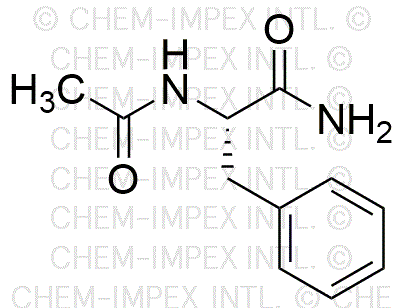Acetyl-L-phenylalanine amide is widely utilized in research focused on:
- Pharmaceutical Development: This compound serves as a building block in the synthesis of various pharmaceuticals, particularly in designing drugs that target neurological disorders.
- Peptide Synthesis: It is commonly used in the production of peptides, enhancing the stability and bioactivity of peptide-based therapeutics.
- Biochemical Research: Researchers employ it to study protein interactions and enzyme activities, providing insights into metabolic pathways.
- Cosmetic Formulations: The compound is included in skincare products for its potential to improve skin hydration and elasticity, appealing to the beauty industry.
- Food Industry: It can be utilized as a flavor enhancer or additive, contributing to the development of healthier food options without compromising taste.
Informations générales
Propriétés
Sécurité et réglementation
Applications
Acetyl-L-phenylalanine amide is widely utilized in research focused on:
- Pharmaceutical Development: This compound serves as a building block in the synthesis of various pharmaceuticals, particularly in designing drugs that target neurological disorders.
- Peptide Synthesis: It is commonly used in the production of peptides, enhancing the stability and bioactivity of peptide-based therapeutics.
- Biochemical Research: Researchers employ it to study protein interactions and enzyme activities, providing insights into metabolic pathways.
- Cosmetic Formulations: The compound is included in skincare products for its potential to improve skin hydration and elasticity, appealing to the beauty industry.
- Food Industry: It can be utilized as a flavor enhancer or additive, contributing to the development of healthier food options without compromising taste.
Documents
Fiches de données de sécurité (FDS)
La FDS fournit des informations de sécurité complètes sur la manipulation, le stockage et l’élimination du produit.
Spécifications du produit (PS)
Le PS fournit une description complète des propriétés du produit, notamment sa composition chimique, son état physique, sa pureté et les exigences de stockage. Il détaille également les plages de qualité acceptables et les applications prévues du produit.
Certificats d'analyse (COA)
Recherchez des certificats d'analyse (COA) en saisissant le numéro de lot du produit. Les numéros de lot et de lot se trouvent sur l'étiquette d'un produit, après les mots « Lot » ou « Lot de fabrication ».
Numéro de catalogue
Numéro de lot/série
Certificats d'origine (COO)
Ce certificat d'exploitation confirme le pays dans lequel le produit a été fabriqué, et détaille également les matériaux et composants utilisés et s'il est issu de sources naturelles, synthétiques ou autres sources spécifiques. Ce certificat peut être requis pour les douanes, le commerce et la conformité réglementaire.
Numéro de catalogue
Numéro de lot/série
Fiches de données de sécurité (FDS)
La FDS fournit des informations de sécurité complètes sur la manipulation, le stockage et l’élimination du produit.
DownloadSpécifications du produit (PS)
Le PS fournit une description complète des propriétés du produit, notamment sa composition chimique, son état physique, sa pureté et les exigences de stockage. Il détaille également les plages de qualité acceptables et les applications prévues du produit.
DownloadCertificats d'analyse (COA)
Recherchez des certificats d'analyse (COA) en saisissant le numéro de lot du produit. Les numéros de lot et de lot se trouvent sur l'étiquette d'un produit, après les mots « Lot » ou « Lot de fabrication ».
Numéro de catalogue
Numéro de lot/série
Certificats d'origine (COO)
Ce certificat d'exploitation confirme le pays dans lequel le produit a été fabriqué, et détaille également les matériaux et composants utilisés et s'il est issu de sources naturelles, synthétiques ou autres sources spécifiques. Ce certificat peut être requis pour les douanes, le commerce et la conformité réglementaire.


